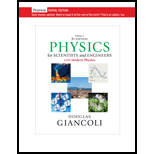
Concept explainers
Explain why birds can sit on power lines safely, whereas leaning a metal ladder up against a power line to fetch a stuck kite is extremely dangerous.
The reason why it is safe for the birds to sit on the power lines, but leaning a metal ladder against a power line is extremely dangerous.
Answer to Problem 1Q
The resistance of the bird is larger compared to the resistance of the wire between the bird’s feet, so that a very little current passes through the bird as it sits on the power line.
A metal ladder leaned against a power line will have a direct contact between the high potential line and ground which implies person standing on the ladder will have a larger potential difference between his hand and feet which produces large current through the person’s body large enough to cause substantial damage.
Explanation of Solution
Even though the bird’s feet are at high potential compared to the ground, the potential difference between the feet of the bird is very little since they are close together on the wire. And also the resistance of the bird is much greater when compared to the resistance of the wire between the bird’s feet. These two resistance are in parallel so that only a very little current will pass through the bird when it sits on the transmission line.
A metal ladder leaned against a power line will have a direct contact to the high potential line and ground so that the person standing on the ladder will have a larger potential difference between his hand and feet.
Even if the person’s resistance is large, the potential difference will also be so large to produce current through the person’s body large enough to cause severe damage or death.
Therefore, it is safe for the birds to sit on the power lines, but leaning a metal ladder against a power line is extremely dangerous.
Want to see more full solutions like this?
Chapter 26 Solutions
Physics for Scientists & Engineers, Volume 2 (Chapters 21-35)
Additional Science Textbook Solutions
Chemistry: A Molecular Approach (4th Edition)
Physics for Scientists and Engineers: A Strategic Approach, Vol. 1 (Chs 1-21) (4th Edition)
Introductory Chemistry (6th Edition)
Microbiology: An Introduction
College Physics: A Strategic Approach (3rd Edition)
Microbiology with Diseases by Body System (5th Edition)
- Is work function of a metals surface related to surface energy and surface tension? What is the need to the work function component in the math of tension of metal surfaces that cannot be provided by existing equations of surface energy and surface tension? What are the key differences in each parameter and variables that allow for a differentiation of each function? What has a more significant meaning work function, surface tension or surface energy? Are there real differences and meaning? Please clarify and if possible provide examples . Does surface tension dependant on thickness of a metal or type of metal surface all having the same thickness? Clearly temperature has a profound change on surface tension what other variables besides temperature are key to surface tension. What if any is there a connection between crystal structure of the element and surface energy and tension? This is NOT a Assignment Question!!!arrow_forwardThe cylindrical beam of a 12.7-mW laser is 0.920 cm in diameter. What is the rms value of the electric field? V/marrow_forwardConsider a rubber rod that has been rubbed with fur to give the rod a net negative charge, and a glass rod that has been rubbed with silk to give it a net positive charge. After being charged by contact by the fur and silk...? a. Both rods have less mass b. the rubber rod has more mass and the glass rod has less mass c. both rods have more mass d. the masses of both rods are unchanged e. the rubber rod has less mass and the glass rod has mroe massarrow_forward
 Physics for Scientists and Engineers: Foundations...PhysicsISBN:9781133939146Author:Katz, Debora M.Publisher:Cengage Learning
Physics for Scientists and Engineers: Foundations...PhysicsISBN:9781133939146Author:Katz, Debora M.Publisher:Cengage Learning College PhysicsPhysicsISBN:9781305952300Author:Raymond A. Serway, Chris VuillePublisher:Cengage Learning
College PhysicsPhysicsISBN:9781305952300Author:Raymond A. Serway, Chris VuillePublisher:Cengage Learning College PhysicsPhysicsISBN:9781938168000Author:Paul Peter Urone, Roger HinrichsPublisher:OpenStax College
College PhysicsPhysicsISBN:9781938168000Author:Paul Peter Urone, Roger HinrichsPublisher:OpenStax College Principles of Physics: A Calculus-Based TextPhysicsISBN:9781133104261Author:Raymond A. Serway, John W. JewettPublisher:Cengage Learning
Principles of Physics: A Calculus-Based TextPhysicsISBN:9781133104261Author:Raymond A. Serway, John W. JewettPublisher:Cengage Learning Physics for Scientists and Engineers, Technology ...PhysicsISBN:9781305116399Author:Raymond A. Serway, John W. JewettPublisher:Cengage Learning
Physics for Scientists and Engineers, Technology ...PhysicsISBN:9781305116399Author:Raymond A. Serway, John W. JewettPublisher:Cengage Learning Glencoe Physics: Principles and Problems, Student...PhysicsISBN:9780078807213Author:Paul W. ZitzewitzPublisher:Glencoe/McGraw-Hill
Glencoe Physics: Principles and Problems, Student...PhysicsISBN:9780078807213Author:Paul W. ZitzewitzPublisher:Glencoe/McGraw-Hill





